Slices of Heaven
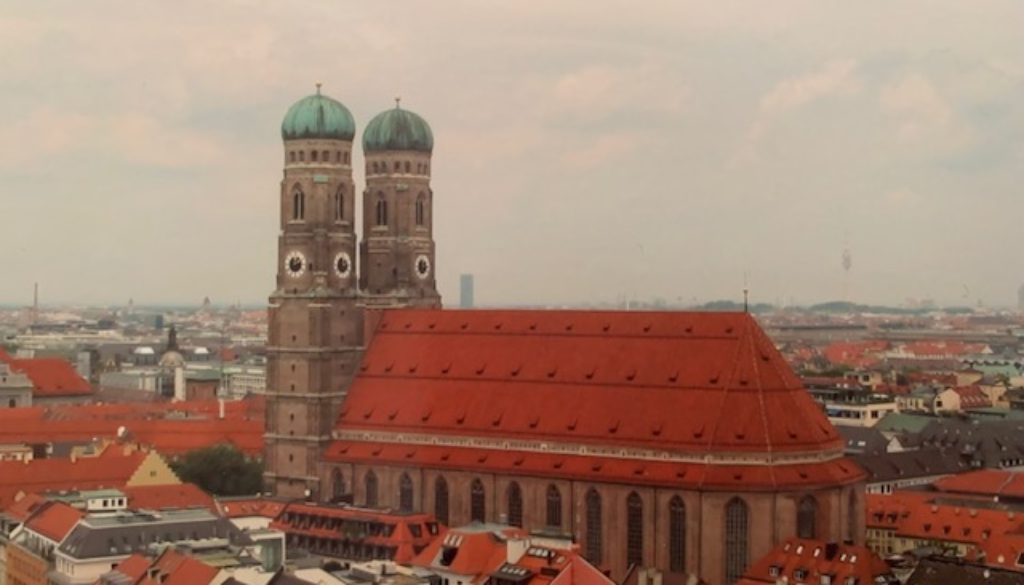
Munich, Germany
May 8, 2007
I am writing from my room at the Park Hilton, between the Isar River and the Englischer Garten. A short walk away, within the park, is a biergarten that features oompah girls serving steins so large they have an undertow. Last night, it pulled us under.
After our morning meetings, my afternoon stroll, and an obligatory business dinner at the Hofbräuhaus, a couple of the Unisys leaders invited me to join them and some counterparts from Air Canada, Cathay Pacific, Air France, and (of course) Qantas at the beer garden. And the oompah girls, like the RAF over Cologne, just kept coming. By the end of the night, everyone was bombed.
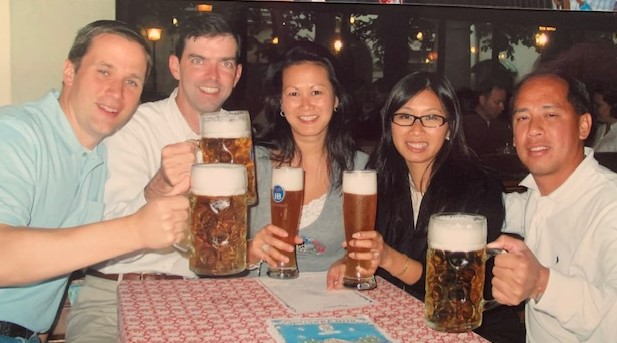
I’ve never squeezed so much beer into so few hours. I enjoyed last evening, but regretted this morning. Somehow, I survived thru lunch, managed to keep it down, and resumed my excursion into Munich.
If the Ludwigstrasse is the Champs d’Élysée, then the Odeonplatz is the Piazza della Signoria, of Munich. Anchoring it are the rococo façade and twirl-topped towers of the Italianate Theatinerkirche.
Grounding the sacred with the profane, the 1841 Feldherrnhalle adjoins the church, as an arched monument to a couple generals from the Thirty Years’ and Napoleonic wars. I paid my perfunctory respect, and returned to the church.
Theatinerkirche is a magnificent specimen of 17th century high baroque. The towers and dome accentuate heavenly aspirations and Mediterranean affect. The façade came a century later, by which time the Theatine Order had begun its decline.
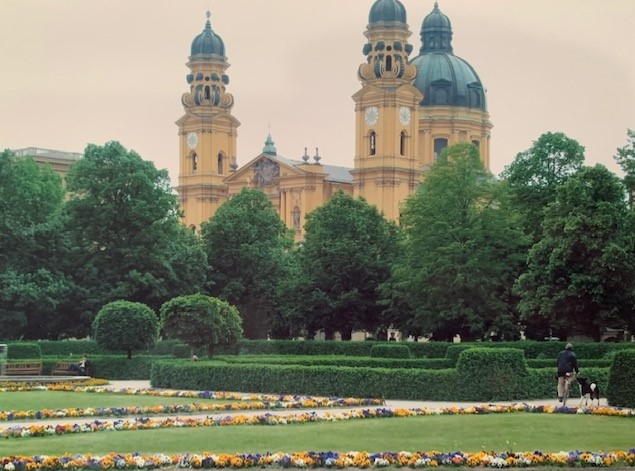
Entering the nave, I felt as tho’ I’d walked into a wedding cake. The columns, arches, and sanctuary, are all bright shades of light, frosty, white. The cupola, chapels, and aisles epitomized Italianate-Bavarian baroque, and influenced its later manifestations.
Munich, like many major European cities, is filled with a half dozen churches that, were they in most any American city, would each be sufficient reason to visit that town. Here they almost blend in, with the exception of the ecclesiastical spires that serve as artistic guideposts on a stranger’s stroll.
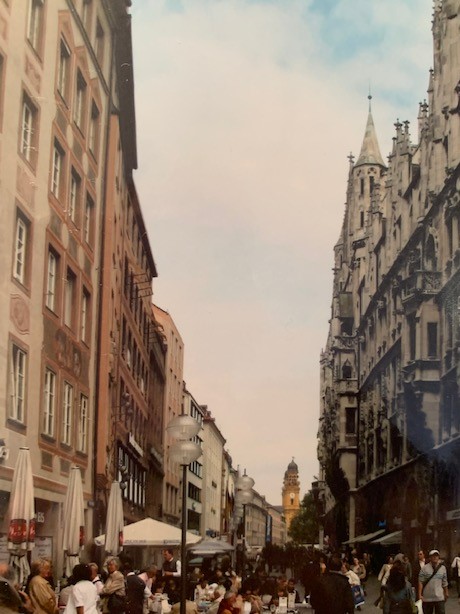
None are more familiar than those of Frauenkirche. What the Duomo is to Florence, this church is to Munich. It’s its instantly recognizable emblem, its mascot in stone. Even so, the distinctive dual towers are more reminiscent of a couple capped beer bottles than the sacred steeples of the Munich cathedral.
The “caps” are meant to resemble the Dome of the Rock. But they are also a retroactive concession to 15th century financial reality, which kept the original towers from being completed according to late-Gothic style of the overall structure. The altered design was less expensive than the original plan, but gave lasting value by providing an indelible landmark.
The interior nave and adjacent aisles are of equal height under a continuous ceiling over 100 feet above the floor. The inordinate ratio of height-to-width, and the number and enormity of the dividing pillars, lends a translucent sensation when sunlight weaves its way into the darkened nave.
Around the corner and a few blocks away is what since the 12th century has been the historic heart of Munich.
In the middle of Marienplatz is the Marian column, erected in 1638 to thank Our Lady for Bavarian release from Swedish occupation in the Thirty Years War. Atop it is a statue of the Virgin as Queen of Heaven, sculpted in 1590 and subsequently relocated from her nearby Frauenkirche.
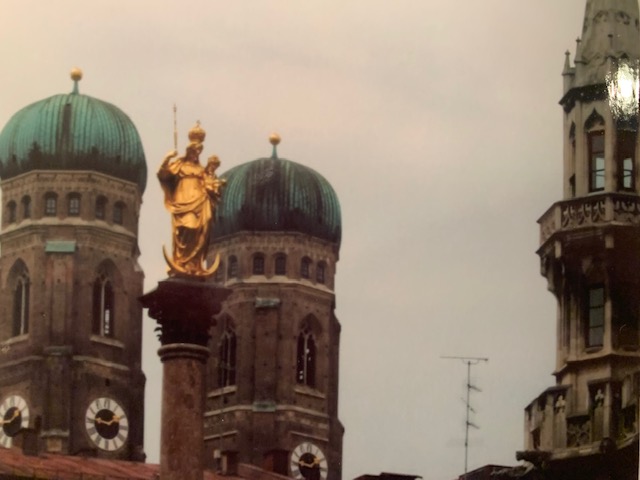
This Marian column was something of an inspiration…not only to this town, but to others. After it was erected, similar pillars rose in several cities north of the Alps, in gratitude for relief from plague, war, or other hardship.
Detouring briefly from the celestial to the secular, around the edges of the plaza are the civic buildings serving modern Munich. The most notable and ornate is the Neues Rathaus, the “new City Hall”.
While I’d never admit this to our German nanny, I don’t find her native tongue particularly appealing. Too many long words, loud tones, and hard edges. I feel like people are yelling at me even when they’re simply thanking me for buying a strudel.
French is more my style, and I can listen to Italian all day. But I can’t acquire a taste for German. It needs to be seasoned with opera to make it palatable. That said, I can’t think of another language with a more appropriate name for a seat of government.
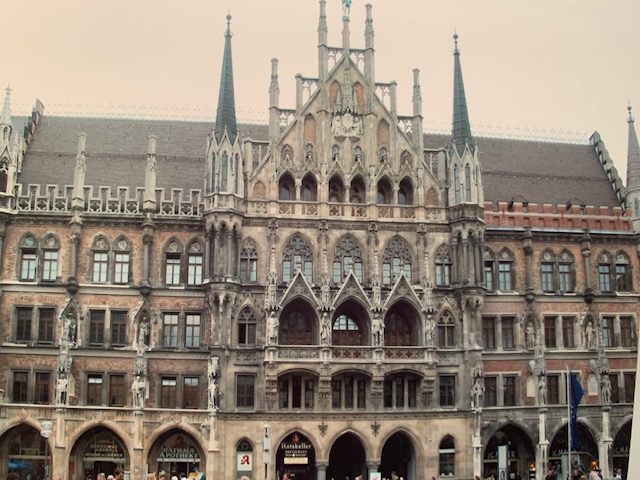
The new Rathaus was apparently inspired by the Town Hall in Brussels. Tho’ built in the late 19th century, it assumed a neo-Gothic design, as an intentional contrast and bourgeois poke in the eye to the predominant architecture of the reigning royal family.
A prime attraction in the main tower of the Rathaus is the two-story Glockenspiel. Each level features chimes and life-size figures portraying daily stories from late-Medieval Munich.
Unfortunately, the only shows are at 11am and noon, so my meetings kept me from attending either. Notwithstanding my rationale for being here, work is becoming an intolerable intrusion on my leisure time.
The clock was constructed only a century ago and is of exquisite craftsmanship. On several visits to Prague I’ve admired the impressive Orloj on its Old Town Hall. While not a glockenspiel, that clock inspired the same urge this one does to pack it up and carry it home to the kids.
A new Rathaus implies an old Rathaus. And, with German reliability, it can be found across the plaza. It’s distinctive spire was initially a gate on the old town wall, but was largely (and faithfully) reconstructed after considerable damage in the Second World War.
Built in the 14th century, the Altes Rathaus looks like something the gingerbread man might live in. It is neo-Gothic in style, tho’ much of it was restored to that look in the 1860s after Renaissance and Baroque modifications in earlier centuries.
More notoriously, its Grand Hall was the spot from which Joseph Goebbels gave a speech on November 9, 1938 that precipitated Kristallnacht. That speech was given fifteen years to the day after Hitler’s failed Beer Hall Putsch spilled into Marienplatz, and placed his repulsive party onto the front page.
After my municipal interlude, I reverted to celestial solace. Bavaria largely resisted the tide of Reformation and retained its Catholic character. The Pope hails from Regensburg, just over an hour from here in the eastern part of the state.
Munich’s many Catholic churches reflect this influence. They are placed neatly around the city like slices of Heaven on a terrestrial trey. I wanted to sample a couple more before the afternoon ended, including the largest Renaissance church on this side of the Alps.
As Theatinerkirche brought Italianate Baroque into Germany, St Michael’s spread Bavarian Baroque throughout central Europe. The façade is captivating, with several Wittelsbachs cast in bronze to form a family tree, while at the roots St Michael guards the doors by vanquishing a demon.
As befits a Jesuit church, the interior reflects a Catholic triumph during the Counter-Reformation. Triumphal arches are incorporated into the chancel arch and side chapels. Constructed in the late 16th century, the barrel vault is the largest aside from that of St. Peter’s in Rome. It freely spans seventy feet, and covers a nave featuring stellar stucco decoration depicting the life of Christ.
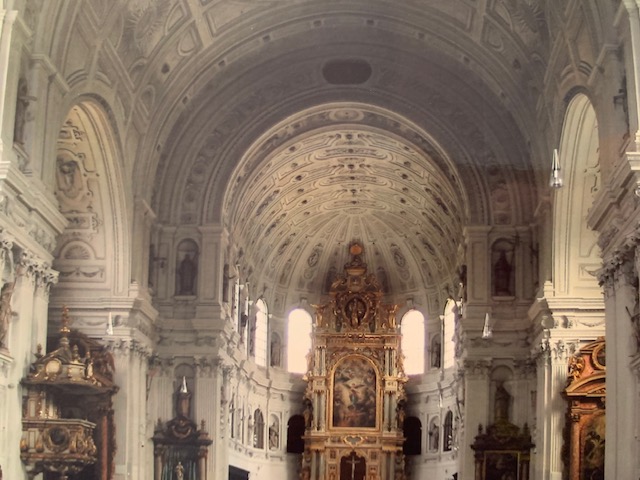
This ecclesiastical masterpiece suffered significant damage during the Second World War, but its immaculate refurbishment is sturdy testimony to an enduring Faith. The stucco was replaced only twenty-five years ago, confirming that good craftsmanship is still possible in an indifferent age.
St Peter’s is apparently the oldest parish in Munich, ostensibly dating to the eleventh century. The current church is not that old, but rose in the relatively recent year of 1368. The tower followed three centuries later, and is the primary draw for the modern tourist.
When we ascend its 300 steps, we see why. The views are outstanding, capturing most of Munich and (on clear days, we were assured) outlines of the distant Alps. Today, with a haze in the air, I had to take their word for it, and settle for a nondescript horizon.
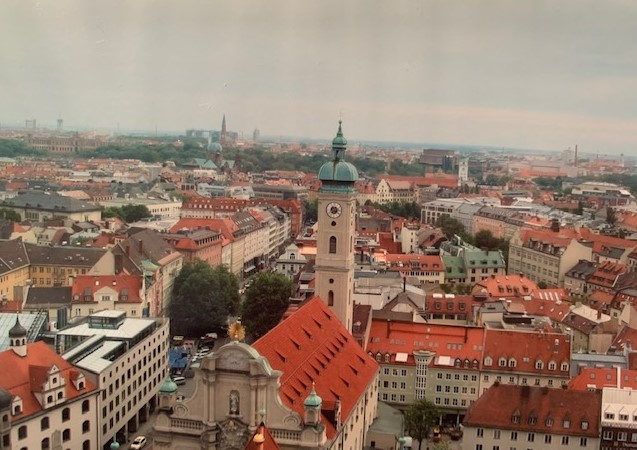
The church was heavily damaged by Allied bombs, but parts of the interior still stun. Over the centuries, it has gathered elements of Gothic, Renaissance, Rococo, and Baroque. The recreated ceiling fresco is remarkable, and the high altar is overwhelmingly ornate.
Descending the steps and leaving the St. Peter’s, I emerged back onto Marienplatz.
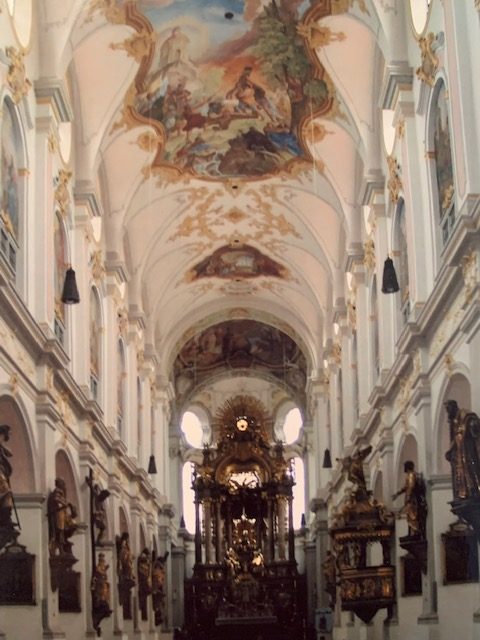
The final stop in my spiritual tour was Heilig-Geist-Kirche, which beckoned to me from my vantage atop the tower of St. Peter’s. Of the original 14th century Gothic hospice that became Holy Spirit Church, only the choir buttresses and the north wall of the nave survived World War II. Most internal furnishings were destroyed as well.
In the 18th century the church was renovated in Baroque style. A bell tower was added soon thereafter, and still stands. The interior is mostly Gothic, leavened with stucco and highlighted by elaborate ceiling frescoes in ornate Baroque and rococo.
On the way back the hotel I passed the beautiful Bayerisches National Museum which, mercifully, was closed. I knew if I went in, I might never come out. As at the Maximilianeum State Parliament Building, I had time only to admire the edifice, and take a photo.
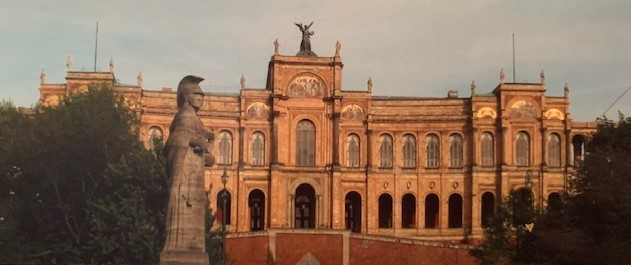
That’s OK. Some things must left for future visits, and this city clearly has plenty of those.
JD



